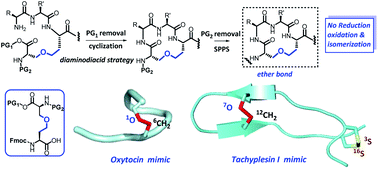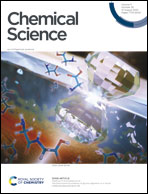Chemical synthesis and biological activity of peptides incorporating an ether bridge as a surrogate for a disulfide bond†
Abstract
Disulfide bridges contribute to the definition and rigidity of polypeptides, but they are inherently unstable in reducing environments and in the presence of isomerases and nucleophiles. Strategies to address these deficiencies, ideally without significantly perturbing the structure of the polypeptide, would be of great interest. One possible surrogate for the disulfide bridge is a simple thioether, but these are susceptible to oxidation. We report the introduction of an ether linkage into the biologically active, disulfide-rich peptides oxytocin, tachyplesin I, and conotoxin α-ImI, using an ether-containing diaminodiacid as the key building block, obtained by the stereoselective ring-opening addition reaction of an aziridine skeleton with a hydroxy group. NMR studies indicated that the derivatives with an ether surrogate bridge exhibited very small change of their three-dimensional structures. The analogs obtained using this novel substitution strategy were found to be more stable than the original peptide in oxidative and reductive conditions; without a loss of bioactivity. This strategy is therefore proposed as a practical and versatile solution to the stability problems associated with cysteine-rich peptides.



 Please wait while we load your content...
Please wait while we load your content...